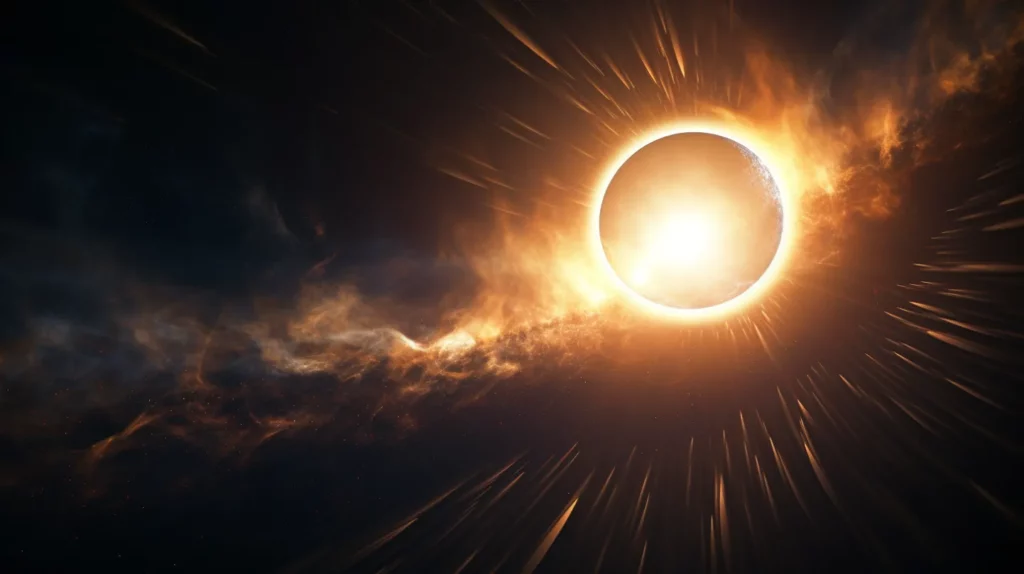19 Interesting Facts About Solar Eclipses You Should Know

Solar eclipses are one of the most spectacular celestial events, never failing to captivate people when the Moon blocks the Sun. These rare astronomical phenomena have fascinated humans for thousands of years.
Key Takeaways
Solar eclipses occur when the Moon passes directly between the Earth and the Sun. For a brief few minutes, the Moon completely or partially blocks our view of the Sun’s bright disk.
Let’s explore some fascinating trivia and information about solar eclipses!
Solar Eclipse Basics
- There are three main types of solar eclipses:
- Total solar eclipses occur when the Moon completely covers the Sun’s disk, revealing the Sun’s outer atmosphere (corona). The path of totality is a narrow track where the total eclipse phase can be viewed.
- Annular solar eclipses happen when the Moon is farthest from Earth and appears smaller than the Sun. This results in a “ring of fire” effect rather than a total eclipse.
- Partial solar eclipses occur when the Moon only partially obscures the Sun’s disk. A large portion of the Sun remains visible.
- Total solar eclipses can never be seen from the North and South Poles. This is because the Moon’s umbral shadow can never extend beyond Earth’s polar regions due to its inclination and orbit.
- Identical solar eclipses occur after a period of 18 years and 11 days. This is known as a Saros cycle, which is the time it takes the Sun, Moon, and Earth to realign in nearly the same geometric configuration.
- There can be between 2 to 5 solar eclipses occurring each year. The exact number depends on the Moon’s orbit in relation to the Sun and Earth. Maximum eclipses happen every 11 years.
- Total solar eclipses occur about once every 1-2 years. This makes them rare events that attract scientists and eclipse chasers willing to travel the world to catch a few minutes in the Moon’s shadow.
Solar Eclipse History

- In ancient times, solar eclipses were seen as bad omens or signs of apocalypse. The abrupt plunging of areas into darkness sparked superstitious fears. Eclipses were thought to be caused by supernatural creatures or religious deities.
- The word “eclipse” comes from the Greek word “ekleipsis” meaning “abandonment”. This reflects the ancient belief that the Sun was abandoned during an eclipse.
- In 585 BC, the Greek philosopher Thales predicted a solar eclipse. This remarkable feat enabled him to stop a battle between the Medes and the Lydians, who were so astonished by the eclipse that they agreed to a truce.
- Mark Twain used a total solar eclipse as a plot device in his novel A Connecticut Yankee in King Arthur’s Court. The protagonist used his knowledge of the upcoming eclipse to save himself from being burned at the stake.
Solar Eclipse Impact
- Temperature drops of 10–15°F are common during a total solar eclipse. As sunlight diminishes, it leads to temporary cooling effects until the eclipse passes.
- Birds and animals often behave strangely or prepare for sleep during totality. With sunlight blocked, they become confused about daytime routines like feeding or starting their evening rituals.
- In Italy, it’s believed that flowers planted during a total eclipse are more colorful when they bloom. Though scientifically unproven, this folk belief persists in some regions.
- The rapid dimming and loss of sunlight can cause physiological stress and anxiety in humans who witness a total solar eclipse.
- A solar eclipse stimulated Einstein’s theory of relativity. Observations of how the Sun’s gravity bent starlight during the 1919 eclipse proved his revolutionary work.
Solar Eclipse Future
- The next total solar eclipse over the continental U.S. occurs on April 8, 2024. It will be visible across a path spanning Texas to Maine, with millions expected to view the spectacle.
- There are no total solar eclipses predicted in the years 2025, 2026, 2029, 2032, 2035, and 2038. Saros cycles and Moon movements account for these uncommon eclipse-free spans.
- After 2050, France will experience the longest total solar eclipse span in 140 years. Occurring on August 12, 2081, totality will last a maximum of 6 minutes and 43 seconds.
- There will be no more total solar eclipses in about 600 million years. Due to the Moon’s orbit expanding away from Earth by 1.5 inches annually, it will eventually be too distant to fully obscure the Sun.
- The longest predicted duration of a total solar eclipse is 7 minutes and 29 seconds, to take place on June 25, 2186. However, it will only be visible over the southern Atlantic Ocean off the coast of Namibia.
Conclusion
Solar eclipses have fascinated humans for millennia with their beauty and rarity. As we learn more about these celestial events through advanced astronomy and physics, we continue to be amazed by the clockwork precision and scale of the solar system.
After reading these 19 facts, you now know much more about the different types of eclipses, their historical significance, their temporary effects here on Earth, and when we can expect to see these spectacular phenomena next. When the Moon blocks the Sun’s light at just the right moment, it allows us to see our star in a remarkable new way and reflect on the wonders of the universe.

